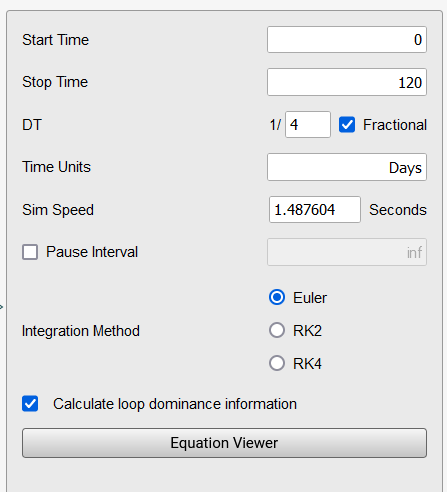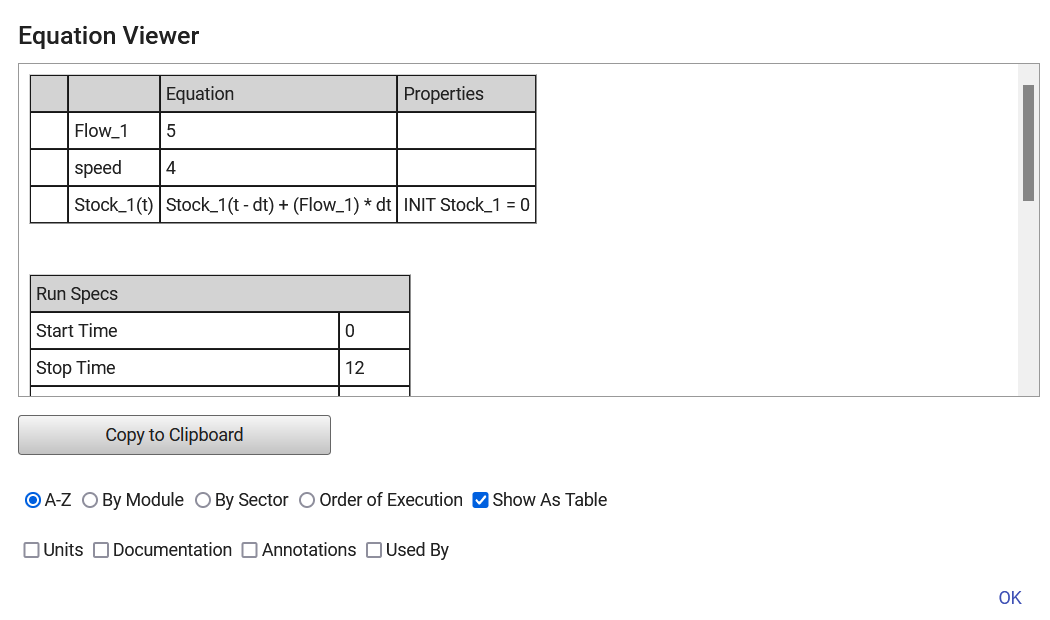Use the Model Settings Properties panel to set Run Specs and Page settings for the model (see Getting Started Online for differences in online editing).
To open the Model Settings, switch to Edit mode and click on an empty space in the model. (If you've closed the Properties panel, you'll need to double-click, or slide it out with the ![]() button appearing at the right of the application.)
button appearing at the right of the application.)

Use these boxes to specify the length of the simulation. The values you enter can be numbers, or you can select a model variable using the ![]() button.
button.
The values you enter here depend on the Time Units you've chosen for the model. For example, if Time Units is set to Months and you want to run the simulation for a year (12 months), you'd specify 0 and 12 (or 1 and 13, if you prefer to report financial style values) as the Start and Stop times. Or, if the unit of time is Years and you wanted to run the simulation from one specified year to another, you could type 1970 and 2010 as the Start and Stop times. If you wanted to run the simulation for 100 years, you could type 0 and 100 as the Start and Stop times.
The value in the "Stop Time" box has to be greater than the value in the "Start Time" box. If you specify variables for one or both the variable values should make this true.
Note: If the value in the DT box isn't evenly divisible into the length of simulation specified by the Start and Stop Time values, Stella Professional chooses the closest multiple of DT for the simulation length.
Note Variable start times are computed at the beginning of normal runs, but never for subsequent runs in Stella Live, sensitivity or optimization. Variable stop times are computed only during normal runs (but at all times).
This box specifies the Delta Time (simulation time step), either by specifying a value in the box, or by specifying DT as a fraction.
Regardless of the method you use, choose a DT small enough to let you capture the shortest time frame of interest in your model. The trade-off here is speed versus accuracy. The more calculations per unit of simulation time, the longer it takes to complete a given simulation. For more about DT, see Overview: DT.
Enter a preferred Time Unit for model simulations in the Time Unit box. The unit of time you enter is used for display purposes and to compute units of measure for flows. It is also used as a basis for time labels (see Setting up Time Bounds) if you use units of time in a language other than English go to the Unit Editor dialog box and add your unit with the corresponding English time unit (for example, Months) as it equation.
Use this option to adjust the speed of the simulation by specifying how many seconds it should take to run the entire simulation. You can enter either a number, or a variable in the model that has a value to be used for the simulation duration. This can be a constant, or computed expression such as (STOPTIME - STARTTIME)/ speed where speed is the number of units of time computed each second. The specified duration variable, or speed in the example, can then be used with a slider or other input control on the interface. You can also have the duration increase during an interval of time or in response to certain conditions (e.g. IF Inventory < 10 THEN 20 ELSE 2 would slow down for low Inventory values).
type in a variable or a number
By slowing the simulation down, you allow model users time to view changes in the model as a run unfolds. This is especially useful on the interface. Use 0 if you do not want to slow down the simulation.
Select the integration method that you want to use for the run:
For more information about these integration methods, see Understanding integration methods.
If checked, this will calculate the dominance of the different feedback loops in the model as described in the Loops That MatterTM Overview and the Loops Panel will open at the end of a simulation. If not checked this information will not be computed and the Loops Panel will not open.
Click on this button to open the Equation Viewer. The online version of this is similar, but somewhat simplified:

Click on OK to close the window.